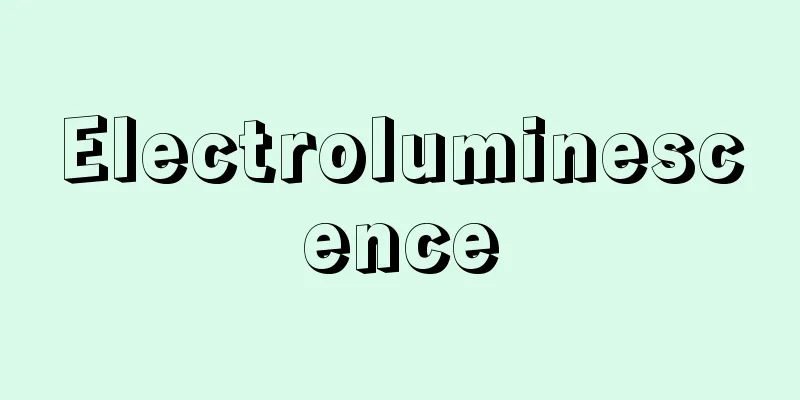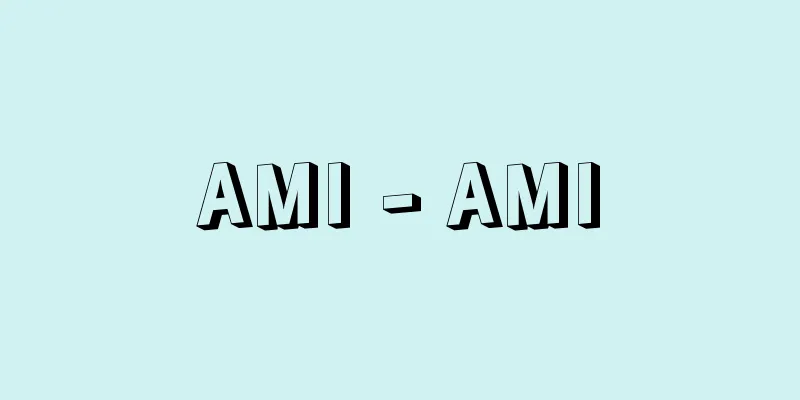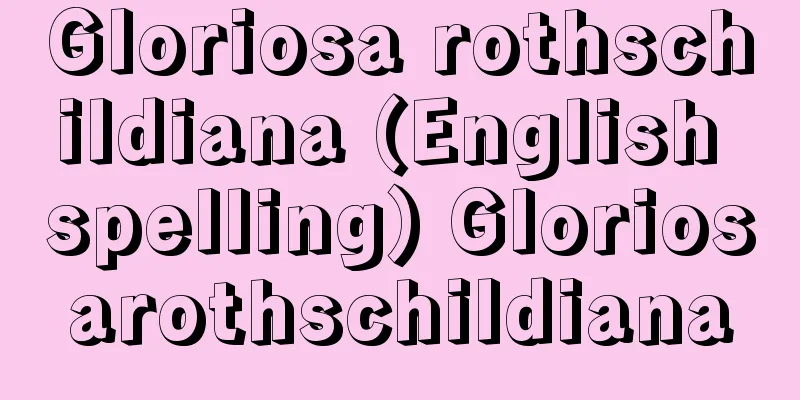Electroluminescence

|
Light emission other than that caused by heat is called luminescence, and the phenomenon of emitting light by electricity is called electroluminescence (EL for short). Usually, it refers to true EL, which is made by sandwiching a light-emitting layer in which phosphors are dispersed in a dielectric between parallel electrodes and applying an electric field to make it emit light, but academically, it also includes injection-type EL, which emits light by injecting a current into a semiconductor. In 1920, B. Gudden and R.W. Phol of Germany discovered that zinc sulfide phosphors emit light when an electric field is applied. Then, in 1936, G. Destriau of France succeeded in making zinc sulfide (phosphor) powder in castor oil (dielectric) emit light when placed between electrodes 0.1 mm apart and applied an alternating current of 50 Hz. This phenomenon is called true electroluminescence, or electroluminescence, and research into it has been active since the 1950s, and it is the basis of today's EL lamps and EL displays, which have been put to practical use. Meanwhile, in 1909, H.J. Round of England discovered that small pieces of silicon carbide emit light while researching crystal detectors. This was confirmed in 1922 by O.V. Losev of the Soviet Union, who attached electrodes to silicon carbide for polishing, passed a current through it, and made it emit light. This phenomenon is called injection-type electroluminescence, and is the basis of what is called a light-emitting diode. [Michinori Iwata] EL lampEL lamps have been attracting attention as an ideal thin-plate surface light source, and have been in practical use in Japan since 1961 (Showa 36). The basic type is a thin-film luminescent layer about several tens of micrometers thick, made by mixing a special zinc sulfide-based fluorescent material with a dielectric, and sandwiching it between two transparent electrodes on one side and driving it with an alternating current (this is called the Detrio type). There are three types on the market: a glass-plastic type in which a transparent electrode is placed on a glass substrate, phosphor is solidified on top with a plastic binder, and aluminum is evaporated to form an electrode; a ceramic type in which white enamel is made on an iron substrate, a luminescent layer of enamel is layered on top of that, and a transparent electrode is attached; and a flexible type in which aluminum foil is placed on a plastic film, a luminescent layer of phosphor is solidified with a plastic binder, and conductive glass paper is layered on top to form an electrode, called the plastic type. All of these are 0.5 to 5 millimeters thick, with each side about 30 centimeters long. LEDs are manufactured with power frequencies of 50-60 Hz, 400 Hz, and 1000 Hz. As the illuminance of a 100 volt, 50 Hz model is low at around 10 lux, they are not used as ordinary lighting, and are used as indicator lights or mood lighting in relatively dark places, as well as for lighting instrument dials, night lights, and foot lights. The color of the emitted light depends on the composition of the fluorescent material, but the basic colors are blue, green, and yellow-red (orange). There are also models with an output of 200 candelas per square meter and a lifespan of 10,000 hours that are used as backlights for LCD displays. [Michinori Iwata] EL displayA panel in which a light-emitting material is sandwiched between transparent electrodes and substrate electrodes arranged in a pattern or matrix, and an electric field is generated by applying voltage, displaying images and text with the same brightness as a cathode ray tube. Compared to liquid crystal, the response speed is much faster, and the power consumption and thickness are a fraction of that of liquid crystal. Furthermore, because it is self-luminous, it has the excellent properties of having a wide viewing angle and not requiring a backlight. Displays in which the light-emitting material is organic are called organic EL displays, and those in which the light-emitting material is inorganic are called inorganic EL displays. Inorganic EL displays are constructed by sandwiching a thin light-emitting film (such as zinc sulfide ZnS) between insulating layers with electrodes attached above and below it; being all solid-state, they are shock-resistant and produce clear, bright images without flicker. The mainstream mass-produced models are monochrome (orange-yellow) 5- to 18-inch models, but orange-yellow-based 8-color + black models are also available. The driving voltage is high at 200 volts, but the lifespan is long at 20,000 hours. Full-color models are in the development stage (as of 2000). The main applications for these products are panels for measuring instruments, factory automation, office automation, and engineering equipment, for use inside automobiles, and for public displays (common in Europe and the United States). Organic EL displays achieve high brightness and high efficiency light emission by applying a low DC voltage of several volts to a thin layer of light-emitting organic compounds; the basic technology was developed in 1987. Since then, research has been intensive, resulting in a variety of light emission colors according to the light-emitting organic compounds, with a lifespan of 10,000 hours. Due to their low operating voltage and low power consumption, several-inch (1 inch is 25.4 mm) displays have been commercialized since 1997 for use in multi-color in-car AV equipment, image displays for digital cameras, and mobile devices. Furthermore, 0.5-inch to several-inch displays have been developed and commercialized as full-color displays with fast response times for mobile devices, videos, and games. [Michinori Iwata] [References] | | | |Example of organic dispersion ©Shogakukan "> Electroluminescent Structure Source: Shogakukan Encyclopedia Nipponica About Encyclopedia Nipponica Information | Legend |
|
熱による以外の光放射をルミネセンスといい、電気によって発光する現象をエレクトロルミネセンス(略してEL)という。普通は、蛍光体を誘電体内に分散した発光層を平行電極で挟み、電界を加えて発光させる真性ELをいうが、学術的には、半導体への電流の注入により発光する注入型ELを含めている。 1920年にドイツのグッデンB. GuddenとポールR. W. Pholが、硫化亜鉛蛍光体に電界を加えると発光することを発見した。ついでフランスのデトリオG. Destriauが1936年に、ひまし油(誘電体)内に硫化亜鉛(蛍光体)粉末を入れたものを0.1ミリメートルに対抗させた電極で挟み、50ヘルツの交流で発光させることに成功した。この現象が真性EL、すなわちエレクトロルミネセンスであり、1950年代から研究が盛んとなり、今日のELランプとELディスプレーの基本となり、実用化されている。他方、1909年にイギリスのラウンドH. J. Roundが鉱石検波器の研究中に、炭化ケイ素の小片が発光することをみいだした。これは1922年にソ連のローセフО.В.Лосев/O. V. Losevにより、研摩用の炭化ケイ素に電極をつけて電流を流し、発光させることで確認された。この現象が注入型ELであり、発光ダイオードとよばれるものの基本となっている。 [岩田倫典] ELランプELランプは薄板状の理想的な面光源であることが注目され、日本では1961年(昭和36)から実用化されている。基本的なものは、硫化亜鉛系の特殊な蛍光物質を誘電体に混合して数十マイクロメートル程度の厚さをもつ薄膜発光層とし、一方が透明の2枚の電極で挟んで交流で駆動するようになっている(これをデトリオ型という)。市販されているものには次の三つの型がある。ガラス基板上に透明電極を置き、その上に蛍光体をプラスチック・バインダーで固め、さらにアルミ蒸着して電極としたものをガラス‐プラスチック型という。鉄基板上に白色ほうろうをつくり、その上にほうろうの発光層を重ね、さらに透明電極をつけたものをセラミックス型、さらにプラスチックフィルム上にアルミ箔(はく)をつけ、さらにプラスチック・バインダーで固めた蛍光体の発光層をつくり、導電性ガラス紙(し)を積み重ねて電極としたフレキシブルなものをプラスチック型という。これらはすべて厚さ0.5~5ミリメートル、1辺の長さが30センチメートル程度である。 電源周波数は50~60ヘルツ、400ヘルツ、1000ヘルツのものがつくられている。100ボルト・50ヘルツのもので10ルクス程度と照度が低いため、普通の照明ではなく、比較的暗い場所の表示灯とかムード照明などのほかに、計器などの文字盤照明、常夜灯、足下灯などに用いられる。発光色は蛍光物質の組成に従うが、青、緑、黄赤(橙(だいだい))が基本色となっている。また、液晶ディスプレーのバックライトとして200カンデラ毎平方メートル、寿命1万時間のものがある。 [岩田倫典] ELディスプレー図形またはマトリックス状に配した透明電極と基板電極間に発光物質を挟み、電圧を加えて電界発光させるパネルで、映像・文字などをブラウン管並みの明るさで表示する。液晶に比べると応答速度ははるかに速く、消費電力や厚さは数分の1と少ない。さらには、自発光であるので視野角は広く、バックライトは不要という優れた性質がある。発光物質が有機物のものを有機ELディスプレー、無機物のものを無機ELディスプレーとよぶ。 無機ELディスプレーは、発光薄膜(硫化亜鉛ZnSなど)を絶縁層でサンドイッチ状に挟んだものの上下に電極を付着させた構造で、全固体式なので衝撃に強く、ちらつきのない鮮明で高輝度な画像が得られる。量産の主流はモノクロ(橙黄色)の5~18型のもので、橙黄色をベースにした8色+黒も製品化されている。駆動電圧は200ボルトと高いが、寿命は2万時間と長い。フルカラーのものは開発の段階にある(2000年現在)。製品のおもな用途は、計測計器、FA・OA・ME機器や自動車内用、公共表示用(欧米に多い)のパネルなどである。 有機ELディスプレーは、薄く積層した発光有機化合物に数ボルトの低い直流電圧を加えて高輝度・高効率の発光が得られるもので、1987年に基礎技術が開発された。その後の研究が盛んとなり、発光有機化合物に応じた種々な発光色をもち、寿命は1万時間である。動作電圧が低く低消費電力であることから、マルチカラーの車載用AV機器、デジタルカメラの画像表示、携帯機器向けに、1997年から数インチ(1インチは25.4ミリメートル)のものが製品化されている。さらに、携帯機器、動画、ゲーム用に応答速度の速いフルカラーディスプレーとして0.5インチから数インチのものが開発され商品化が進められている。 [岩田倫典] [参照項目] | | | |有機分散型の例©Shogakukan"> エレクトロルミネセンスの構造 出典 小学館 日本大百科全書(ニッポニカ)日本大百科全書(ニッポニカ)について 情報 | 凡例 |
<<: Elegy - Ereji (English spelling)
Recommend
Kizomeka Mirure - Kizomeka Mirure
...There are many horticultural varieties, includ...
Tukaram-Gātha (English spelling)
… He spoke harshly of his dissatisfaction with th...
《Phonological Pronunciation Examples》 - Oninkana Yorei
…Ota Zensai, who followed Motoori Norinaga and wr...
Taney, Roger Brooke
Born March 17, 1777 in Calvert, Maryland Died: Oct...
Ruge, Arnold
Born: September 13, 1803, Bergen [died] December 3...
Woolly Nylon
〘Noun〙 (woolly nylon) Nylon thread that has been g...
Khalkha language - Khalkhago (English spelling)
One of the Mongolian languages. It is spoken in al...
Baptistery - Senreido (English spelling)
A building attached to a church for the ceremony o...
Ikata Toji - Ikata Toji
…Most of the town area is mountainous, and includ...
Toshiyuki Hasegawa
Western-style painter. Born on July 9, 1891 in Ya...
Event (performance) - Event
...Apart from its usual meaning of "playing,...
Arachnida
…Also called the Merostomata. (3)Arachnida: Spide...
Muroto Typhoon
This refers to two super typhoons that made landf...
Orthomagmatic deposit - Orthomagmatic deposit
A type of igneous deposit. Sometimes simply called...
Spine - Vertebral column; spine
Same as the spinal column. One of the internal ske...









